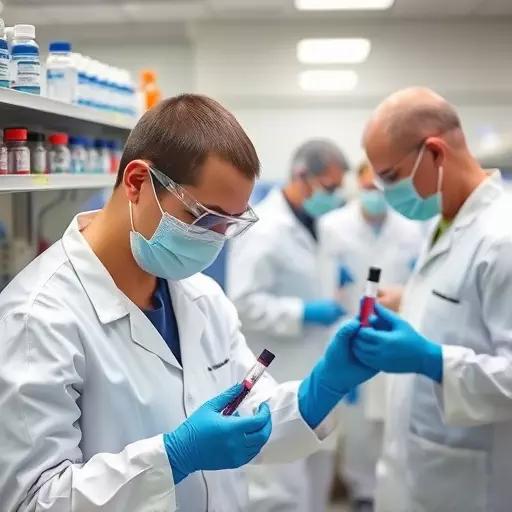In Grand Rapids-Kentwood-Muskegon's competitive scientific landscape, efficient lab design and optimized staffing are crucial. Key strategies include tailored workspace layouts, technology integration like digital displays and cloud management, and comprehensive compliance planning with standardized procedures and training. Implementing automated workflows, centralized regulatory knowledge, real-time collaboration tools, and strict version control ensures peak efficiency, data integrity, and adherence to regulations in multi-site laboratory networks.
Creating collaborative lab workspaces in Grand Rapids-Kentwood-Muskegon requires a strategic approach that goes beyond physical design. This article explores best practices for optimizing lab spaces, staffing, and technology to enhance collaboration across multiple sites. We delve into assessing workspace design tailored to the region, efficient staffing strategies for multi-site networks, streamlined compliance management, effective communication, and equipment choices that foster a dynamic research environment. By implementing these practices, labs in Grand Rapids can achieve peak efficiency and manage compliance effectively within their networks.
- Assessing Lab Workspace Design for Collaboration in Grand Rapids-Kentwood-Muskegon
- Staffing Strategies: Optimizing Efficiency in Multi-Site Laboratory Networks
- Implementing Best Practices for Streamlined Compliance Management
- Fostering Communication and Data Sharing Across Sites
- Equipment and Technology Choices to Enhance Collaborative Capabilities
Assessing Lab Workspace Design for Collaboration in Grand Rapids-Kentwood-Muskegon

In the dynamic landscape of scientific research and development, designing collaborative lab workspaces is paramount to fostering innovation in Grand Rapids-Kentwood-Muskegon. When structuring lab spaces, prioritizing collaboration involves more than just aesthetics; it requires strategic planning to optimize workflow and communication. To achieve peak efficiency, consider the unique needs of various lab disciplines and staff sizes. Efficient layout design, including dedicated areas for teamwork, communication hubs, and well-defined traffic flows, can significantly enhance collaboration. Additionally, incorporating technology like shared digital displays and cloud-based data management systems facilitates real-time collaboration and knowledge sharing among teams distributed across multiple sites in the network.
Managing compliance is an integral aspect of maintaining a successful multi-site laboratory network. Ensuring consistent standards and protocol adherence across diverse locations requires robust management strategies. Implementing standardized operating procedures, integrating compliance software, and conducting regular training sessions can help maintain regulatory alignment. By addressing these considerations, lab managers in Grand Rapids-Kentwood-Muskegon can create environments that not only support collaborative work but also navigate the complexities of managing compliance efficiently, ultimately contributing to the network’s overall success and scientific advancement.
Staffing Strategies: Optimizing Efficiency in Multi-Site Laboratory Networks

In the dynamic landscape of lab work in Grand Rapids-Kentwood-Muskegon, optimizing staffing strategies is key to achieving peak efficiency across multi-site laboratory networks. This involves a nuanced approach that balances skill sets with workload demands. By implementing flexible staffing models, such as cross-training staff to handle various tasks, you can ensure that resources are allocated effectively during periods of high demand. Additionally, leveraging technology for automated processes and data management streamlines workflows, allowing personnel to focus on more complex, value-added activities.
Managing compliance in these networks is another critical aspect. Standardized procedures and regular training sessions ensure that all sites adhere to quality control standards and regulatory requirements. Effective communication channels facilitate the seamless exchange of information and best practices across locations, fostering a culture of consistency and accountability. This holistic approach not only enhances operational efficiency but also reinforces the integrity of data generated in lab work across the Grand Rapids-Kentwood-Muskegon region.
Implementing Best Practices for Streamlined Compliance Management

In the dynamic environment of lab work in Grand Rapids-Kentwood-Muskegon, optimizing staffing for peak efficiency is paramount. To achieve this, organizations must implement best practices that streamline compliance management. Start by centralizing regulatory knowledge and ensuring all personnel are trained on the latest guidelines. This standardization facilitates consistent application of protocols across different sites within multi-site laboratory networks.
Leverage technology to automate compliance tracking and reporting. Digital platforms can efficiently capture and record data, reducing manual effort and minimizing errors. Regular audits and feedback loops should be established to identify areas for improvement in both procedures and personnel performance. Such continuous optimization ensures that the lab remains not just compliant but also operates at its highest level of efficiency.
Fostering Communication and Data Sharing Across Sites

In a region like Grand Rapids-Kentwood-Muskegon, where multiple laboratory sites collaborate and share resources, efficient communication and data sharing are paramount to achieving peak efficiency. Optimizing lab staffing across these sites involves creating a unified environment where scientists and technicians can seamlessly collaborate despite physical distances. This includes implementing digital platforms for real-time communication, cloud-based storage systems to facilitate data access and backup, and clear protocols for version control and data management.
Managing compliance in multi-site laboratory networks is another critical aspect. Each site must adhere to the same regulatory standards and protocol, ensuring that data integrity and patient safety are not compromised. Standardized training programs and regular audits can help maintain consistency across sites. Additionally, utilizing centralized systems for document management and task allocation streamlines operations, enhances accountability, and ensures compliance with industry regulations, thereby fostering a cohesive and productive lab environment in the Grand Rapids-Kentwood-Muskegon area.
Equipment and Technology Choices to Enhance Collaborative Capabilities

In creating collaborative lab workspaces, strategic equipment and technology choices play a pivotal role in enhancing overall productivity and efficiency, especially for lab work in Grand Rapids-Kentwood-Muskegon areas. Opting for state-of-the-art instruments and digital platforms facilitates seamless data sharing and communication among team members scattered across multiple sites. This is crucial for managing compliance in multi-site laboratory networks, ensuring that every location operates with consistent standards and protocols.
To optimize lab staffing for peak efficiency, consider implementing technology that streamlines workflow processes. Automated systems for sample tracking, cloud-based storage for documents and results, and video conferencing tools for virtual meetings can significantly reduce manual tasks, enhance collaboration, and improve the overall laboratory management experience. These technological interventions not only cater to the operational needs but also align with the evolving demands of modern laboratory practices, making it easier to adapt to changing regulations and protocols.
